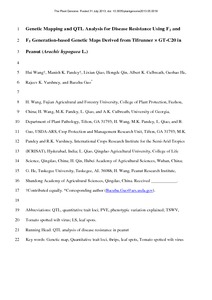Genetic Mapping and QTL Analysis for Disease Resistance Using F2 and F5 Generation-based Genetic Maps Derived from Tifrunner × GT-C20 in Peanut (Arachis hypogaea L.)
Abstract
One mapping population derived from Tifrunner × GT-C20 has shown great potential in developing high dense genetic map and identification of QTLs for important disease resistance, Tomato spotted wilt virus (TSWV) and leaf spot (LS). Both F2 and F5 generation- based genetic maps were constructed previously with 318 and 239 marker loci, respectively Higher map density could be achieved with the F2 map (5.3 cM/locus) as compared to the F5 (5.7 cM/locus). QTL analysis using multi-environment phenotyping data from F8 and higher generation for disease resistance identified 54 QTLs in the F2 map including two QTLs for thrips (12.14 – 19.43% PVE), 15 for TSWV (4.40–34.92% PVE) and 37 for LS (6.61– 27.35% PVE). Twenty-three QTLs could be identified in F5 map including one QTL for thrips (5.86% PVE), nine for TSWV (5.20 – 14.14% PVE) and 13 for LS (5.95–21.45% PVE). Consistent QTLs identified in each map have shown higher phenotypic variance than non-consistent QTLs. As expected, the number of QTLs and their estimates of phenotypic variance were lower in the F5 map. This is the first QTL study reporting novel QTLs for thrips, TSWV and LS in peanut, and thus, future studies will be conducted to refine these thrips, TSWV and LS in peanut, and thus, future studies will be conducted to refine these

